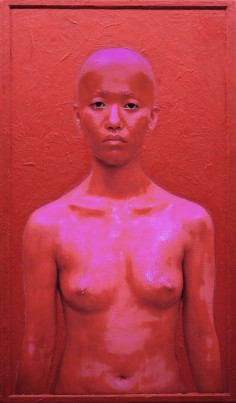EXONEMO
BODY PAINT
SERIES

source: exonemo
To we smart phone-affixed contemporaries, to connect to the Internet at all times and in all places is to complete our person. This work uses body painting to examine our physical definitions, our physicality, in a world of networked information devices.
Each work in this portrait series features a person, nude, shaved, and painted entirely in a single shade of color, displayed on an LCD which has been entirely painted in the same color except for the human subject on the screen. With these boundaries erased, the background and foreground being a human body and an electronic display body, each covered in the same color of paint, the subject can be said to become the sense of ambiguity and confusion, and a questioning of the definition of whether the individual depicted is human being or representation.
Apart from these formalistic aspects, this work also deals with issues of “existence” within media. The human body has a fairly well understood longevity horizon, but the longevity horizon for data, and paint, and art remains open to debate. The multiple time scales of body art, figurative painting, and media art engage one another as the work seeks a common ground concerning the present, and existence itself.
.
.
.
.
.
.
.
source: exonemo
The artist unit e x o n e m o was formed in 1996 by AKAIWA Yae and SEMBO Kensuke. http://exonemo.com. Their experimental projects are typically humorous and innovative explorations of the paradoxes of digital and analog computer networked and actual environments in our lives. Their The Road Movie won the Golden Nica for Net Vision category at Prix Ars Electronica 2006. They have been organizing the IDPW gatherings and “Internet Yami-Ichi” since 2012.
.
.
.
.
.
.
.
source: exonemo
Yae Akaiwa and Kensuke Sembo meet during college, she studying sculpture and he studying design. They start working on projects together after graduation. The word “Exonemo” is entirely made-up and meaningless : not betraying its creators’ country of origin it avoids any narrow-minded reading of their work through the filter of “Japaneseness”. It also stays completely open and allows the artists to make it evolve without having to observe an underlying agenda. Finally, its pure artificial nature unsures that all searches on the Internet link to the duo’s website.
The Internet is indeed their first and main instrument, as Akaiwa and Sembo chose from the very beginning to make the Web both their art gallery (exonemo.com) and main creative tool, for its easy access and quick sharing qualities. The question of how the Internet and computers change our perception of the world naturally becomes the focus of Exonemo’s interactive, fun, immediately comprehensible and strangely poetical works.
In addition to works displayed on the Internet, since 2000 the duo has also participated in more than 40 festivals and exhibitions worldwide. The installations created for those events also require the public’s participation and play around the space in which they are presented. In “Shi Ka Ku No Mu Kou” (“on the other side of the square”) a graphic tablet is left at the visitor’s disposal in a room which lights turn out as soon as someone picks up the stylus. One must then draw in the dark and the results are showed on the walls of an adjacent room. Exonemo have also performed on stage improvising visual and sound pieces with circuit-bent toys. They have also organized circuit-bending workshops and improvisation jam sessions with children.
Far from the dryness of conceptual art, Exonemo focuses above all things on fun and communication, as proves the Japanese edition of the Dorkbot festival which the duo curates, getting together a heterogeneous bunch of musicians, artists and handymen, “anyone willing to show something funny with electricity”.
Exonemo’s work allows the public to take some sort of revenge at technologies that are increasingly complex and important in our daily life, demystifying it through destruction, error and mutation processes before eventually reappropriating it in a creative way. Akaiwa and Sembo never consider progress an end in itself, but as an ever changing tool retaining the power to break the conscience of both the artist and public, increasing it tenfold with a heavy dose of unexpected and creating a new beauty.

